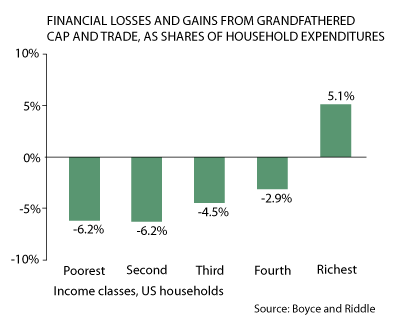How Does it Work?
Cap and Dividend is a comprehensive policy solution to reduce carbon emissions. Large carbon-emitting firms such as coal plants or oil companies pay for the right to pollute by purchasing annual “carbon permits” at public auction. The revenues from the auction are distributed to residents on a per-capita basis.
Lawmakers set a cap on carbon emissions and create enough one-ton carbon permits to match the cap. Companies purchase the permits at regularly scheduled auctions. If an emitter fails to purchase enough permits in any given year—or “compliance period”—they’ll face steep fines. As in other forms of Cap and Trade, companies are free to sell any excess permits to other companies who need them. Over time, the cap is ratcheted down—by reducing the number of permits available at auction—until the economy reaches the desired level of emissions reductions.
Auctioning the permits under Cap and Dividend generates revenue that is distributed on a per-capita basis—much like Alaska’s Permanent Fund, which pays out an annual dividend of oil earnings to each resident of the state. (For other possible uses of the revenue, see Sightline’s Cap and Trade 101 primer.)
Fairness
How does Cap and Dividend affect families of different incomes? As the chart shows, the system will more than offset the impact of energy price increases for low- and middle-income families who consume far less than wealthy families. Under Cap and Dividend, everyone pays more for carbon-intensive energy, but the auction revenue dividend will more than cover the added expense for most families.

Just so, those who invest in efficiency—by reducing their carbon footprints and exposure to energy costs—could end up ahead, because everyone will receive the same dividend. In other words, Cap and Dividend has a built-in incentive for individuals and businesses to reduce their emissions—and it provides a financial cushion for those who need help.
Multiple studies have shown that the program is fair among different regions of the United States. Even allowing for the differences in electricity production—hydropower in the Pacific Northwest, coal in the Midwest—the differences in carbon footprints are small when emissions from transportation, industry, waste, and other sources are factored in.
Other resources:
Image: James K. Boyce and Matthew Riddle, “Cap and Dividend: How to Curb Global Warming While Protecting the Incomes of American Families,” November 2007.







